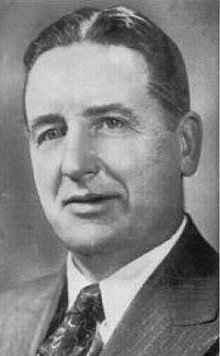Lee E. Emerson
| Lee Earl Emerson | |
|---|---|
 |
|
| 69th Governor of Vermont | |
|
In office January 4, 1951 – January 6, 1955 |
|
| Lieutenant | Joseph B. Johnson |
| Preceded by | Harold J. Arthur |
| Succeeded by | Joseph B. Johnson |
| 62nd Lieutenant Governor of Vermont | |
|
In office 1945–1949 |
|
| Governor | Mortimer R. Proctor Ernest W. Gibson, Jr. |
| Preceded by | Mortimer R. Proctor |
| Succeeded by | Harold J. Arthur |
| Member of the Vermont Senate | |
|
In office 1943–1945 |
|
| Member of the Vermont House of Representatives | |
|
In office 1938 |
|
| Personal details | |
| Born |
December 19, 1898 Hardwick, Vermont |
| Died | May 21, 1976 (aged 77) Berlin, Vermont |
| Political party | Republican |
| Spouse(s) | Dorcas Ball Emerson |
| Alma mater |
Syracuse University George Washington University Law School |
| Profession | Attorney |
| Religion | American Baptist Churches USA |
Lee Earl Emerson (December 19, 1898 – May 21, 1976) was the 69th Governor of Vermont.
He was born in Hardwick, Vermont, on December 19, 1898, and moved to Barton, Vermont, at the age of 16. He graduated from Barton Academy in 1917, and served in the United States Army during World War I as a member of the Students' Army Training Corps. Emerson received an A.B. from Syracuse University in 1921 and a LL.B. from George Washington University Law School in 1926. He practiced law in Barton.
He was elected as a Republican to the Vermont House of Representatives in 1938 and served two terms. He was elected Speaker of the House in his second term, serving from 1941 to 1943. He was elected to the Vermont Senate in 1942, served from 1943 to 1945, and was elected President Pro Tempore. He was elected Lieutenant Governor of Vermont in 1944 and 1946, serving from 1945 to 1949.
Throughout much of Vermont history Governors and Lieutenant Governors had served two one-year terms, and later one two-year term as part of the Republican Party's "Mountain Rule." However, Ernest W. Gibson, Jr. had successfully challenged the established structure to win the governorship in 1946. Gibson defeated Emerson in the 1948 Republican primary and went on to win reelection to a second term. Emerson's fellow conservative Harold J. Arthur succeeded Emerson as Lieutenant Governor. When Arthur unexpectedly became governor in 1950 after Gibson resigned to accept a federal judgeship, Arthur served out Gibson's term but declined to run for a full term himself, clearing the way for Emerson's comeback. Emerson was elected Governor in 1950 and reelected in 1952, serving from 1951 to 1955. (Arthur instead ran for the U.S. House and lost the Republican primary to Winston Prouty, who went on to win the general election.)
...
Wikipedia
